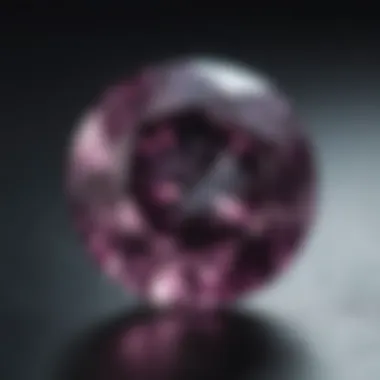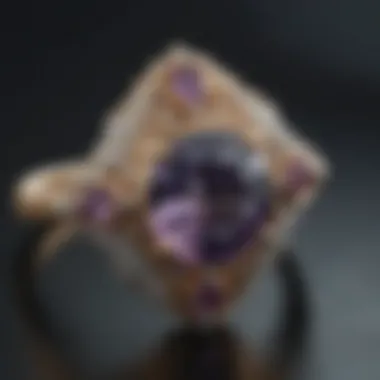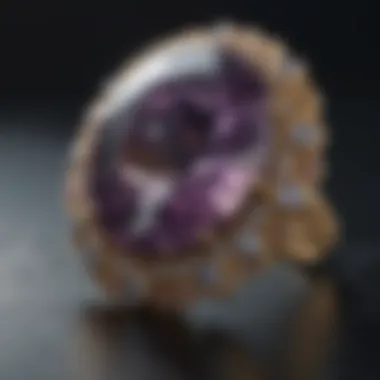Exploring Alexandrite: The Enigmatic June Birthstone


Intro
Alexandrite is not your average gemstone. Known for its ability to change color depending on the light, it captivates both collectors and jewelry designers alike. Its allure goes beyond beauty. The stone has a rich history that intertwines with cultural significance and metaphysical beliefs. In this article, we will delve into the various facets of alexandrite, from its properties and historical context to its contemporary applications in jewelry.
Gemstone Overview
Definition of Gemstones
Gemstones are precious or semi-precious stones, valued for their rarity, beauty, and durability. They are typically cut and polished for use in jewelry. Alexandrite fits this definition as it is sought after for its unique aesthetic and enchanting properties. Its remarkable quality makes it a standout piece in any collection.
Classification of Gemstones
Gemstones fall into two primary categories: precious and semi-precious. Precious stones include diamonds, rubies, sapphires, and emeralds. Alexandrite, though sometimes classified as semi-precious, has gained significant recognition due to its distinctive features, which have heightened its desirability and market value.
Historical Significance
Origins of Gemstone Use
The use of gemstones can be traced back to ancient civilizations. Earliest records show that people valued these stones not only for adornment but also for their supposed magical properties. Alexandrite, specifically, gained prominence in the 19th century when it was first discovered in Russia's Ural Mountains. Its color-changing property was a fascination among royals and jewelers.
Cultural Insights: Gemstones in Ancient Civilizations
Throughout history, gemstones like alexandrite have held various meanings across cultures. In ancient Egypt, gemstones were often buried with pharaohs, believed to protect them in the afterlife. Similarly, other cultures assigned specific meanings, making gemstones integral parts of their history and rituals. Alexandrite has come to symbolize transition and transformation due to its unique ability to shift color with light exposure.
Alexandrite is not just a decorative stone; it represents a bridge between past and present, reflecting change in both nature and the human experience.
Understanding the history of alexandrite enhances the appreciation for its nuanced charm and cultural significance. This knowledge transforms it from a mere accessory into a meaningful addition to one's collection.
Foreword to Alexandrite
Alexandrite stands as one of the most intriguing gemstones, particularly as the birthstone for those born in June. Understanding its nature is crucial for gemstone enthusiasts, collectors, and designers. This introduction serves as a gateway into the remarkable world of alexandrite, unveiling its unique traits and significance.
Overview of Birthstones
Birthstones have a long history, with each month associated with a specific gem. Traditionally, these stones are thought to hold unique properties that resonate with individuals born during that month. Alexandrite, in particular, is celebrated for its stunning color-changing abilities. This gem is formed under specific geological conditions, primarily in Russia, with a relatively recent introduction in the gemstone market.
People often choose to wear their birthstone, as it symbolizes personal attributes and characteristics. Many believe that birthstones can offer protection, healing, and good luck. The allure of alexandrite extends beyond its aesthetic appeal, embodying the complexity of nature itself.
Significance of June Birthstone
As the birthstone for June, alexandrite carries special significance not only in terms of personal symbolism but also culturally. June-born individuals may find particular pride in owning this gem, as it is often linked with transformation and change due to its color-changing phenomenon. Color can shift from a vibrant green in daylight to a deep red or purplish hue under incandescent light.
Its rarity adds to its mystique. Unlike other birthstones that are more commonly found, quality alexandrite is scarce. This unique trait makes it highly desirable among collectors and jewelry designers alike. Beyond aesthetics, society has imbued this stone with meanings related to fortune, prosperity, and strength.
"The allure of alexandrite lies in its ability to transform, much like those who wear it, embodying resilience and change."
In summary, the introduction to alexandrite sets the stage for a deeper exploration of its characteristics, historical significance, and contemporary relevance. A comprehensive understanding of this gem enriches appreciation for its beauty and importance in the world of gemstones.
Characteristics of Alexandrite


The characteristics of alexandrite are integral to understanding its unique appeal and intrinsic value. Beyond its historical significance, alexandrite possesses captivating traits that set it apart from other gemstones. This section delves into the gem's color-change phenomenon, chemical composition, and physical properties, emphasizing how each aspect contributes to its rarity and desirability.
Color-Change Phenomenon
One of the most remarkable features of alexandrite is its ability to exhibit a color change based on the light source. In natural light, this gemstone displays a rich green hue, while under incandescent light, it transforms to a warm, reddish-purple. This duality not only enhances its visual appeal but also adds to its mystique. The phenomenon is a result of the crystal's unique chemical structure, which allows it to absorb and reflect light differently.
"The color-change phenomenon of alexandrite is not merely aesthetic; it symbolizes change and adaptability."
This quality makes alexandrite highly sought after by collectors and enthusiasts alike. Its variability allows for a deep connection to personal significance as each change can represent different emotions or experiences.
Chemical Composition
The chemical makeup of alexandrite primarily consists of chrysoberyl, an aluminum beryllium oxide. The incorporation of trace elements such as chromium is vital for its color change. Chromium ions replace aluminum ions in the crystal lattice, impacting how light interacts with the stone.
Understanding the chemical composition is essential for recognizing the value of different specimens. Stones with higher concentrations of chromium tend to exhibit more dramatic color changes and are therefore more prized in the market.
Physical Properties
The physical properties of alexandrite substantiate its appeal as a durable gemstone suitable for various types of jewelry.
Hardness
In terms of hardness, alexandrite rates 8.5 on the Mohs scale. This notable hardness enhances its suitability for everyday wear, making it a reliable option for rings, necklaces, and other jewelry pieces. The beneficial characteristic of hardness ensures that it can withstand scratches and general wear, maintaining its brilliance over time. The unique feature of its hardness makes it less susceptible to damage compared to softer stones. However, it is important to still treat it with care to preserve its beauty.
Stability
Stability is another key aspect of alexandrite. It exhibits excellent stability when exposed to heat and light, contributing to its enduring popularity. This stability allows for successful treatments, like faceting, without significant risk of damage. The advantage of this stability means that collectors can invest in quality pieces without the fear of deterioration. Nevertheless, while alexandrite is pretty robust, care should always be taken to maintain its pristine condition.
Historical Context of Alexandrite
Understanding the historical context of alexandrite adds depth to its allure and significance. This gemstone has not only captivated collectors and enthusiasts but also played a role in various cultures throughout history. Its discovery and use reveal much about its place in society and its meaning over time.
Discovery and Origin
Alexandrite was first discovered in the Ural Mountains of Russia in the 1830s. Named after Tsar Alexander II, this gem quickly gained fame for its remarkable color-changing properties. Characterized by its ability to shift between green in daylight to red under incandescent light, alexandrite became a symbol of luxury and exclusivity. This dual nature appealed to the wealthy and influential, establishing its reputation as a favored stone among Russian royalty. The rarity of natural alexandrite boosts its mystique, adding historical importance as not just a gemstone but a precious artifact symbolizing an era of imperial grandeur.
Historical Uses and Significance
Royal Associations
One of the captivating aspects of alexandrite is its strong connection to royalty. The stone was often worn by members of Russian nobility in the 19th century. Its distinct color change was seen as a representation of the duality of nature, mirroring the lives of the aristocrats who owned it. Royal associations offered the gemstone a prestigious status, making it a coveted item for the elite. This connection has kept alexandrite in the public eye over the years, reinforcing its value and desirability.
Cultural Symbolism
Culturally, alexandrite carries significant meanings as well. It was believed to bring luck and ward off misfortune, making it a popular choice for various types of jewelry. People viewed it as a protective stone, particularly in its early associations with the Russian Empire. Furthermore, its unique color-changing property symbolizes adaptability and transformation, resonating with those looking for personal growth or change. This cultural significance endures, making alexandrite more than just a beautiful gem; it represents deeper sentiments that continue to attract individuals across different backgrounds.
Market Value and Rarity
The market value and rarity of alexandrite play a crucial role in understanding its position within the gemstone realm. This section explores the various factors that contribute to the valuation of this unique gem, allowing enthusiasts and collectors to appreciate the nuances that define its monetary worth.


Factors Influencing Value
Color Quality
Color quality is one of the primary determinants of an alexandrite's value. The unique ability of alexandrite to change color under different lighting conditions is a stunning feature. The most sought-after color change is from green in daylight to red or purplish-red in incandescent light. This dramatic transformation is what sets alexandrite apart from other stones.
Key characteristics of color quality include hue, saturation, and tone. Among these, hue is especially significant. For instance, alexandrites that exhibit strong, vibrant hues will command higher prices in the market. Moreover, stones with less noticeable color change are generally considered less valuable. It is also worth noting that the selling price can fluctuate greatly based on the intensity of the colors displayed. Therefore, when investing in alexandrite, the distinctive beauty of its color must not be overlooked.
Clarity and Cut
Clarity and cut are essential aspects that also influence the overall market value of alexandrite. Clarity refers to the presence of inclusions or blemishes within the stone. Higher clarity generally translates to a greater value. Buyers prefer stones that are eye-clean, meaning no inclusions are visible to the naked eye. The cut of the gemstone is equally important. A well-executed cut enhances the stone's ability to display its color-changing properties effectively, allowing light to interact with the gem optimally.
A well-designed cut can bring out the stone's brilliance, which adds to its allure and value. Different cuts may influence how the stone appears in terms of size and visual impact. However, a poorly executed cut can diminish the gem's value, regardless of its inherent quality. As such, both clarity and cut factor significantly into market valuations.
Rarity
Rarity is a foundational aspect that drives the market value of alexandrite. Alexandrite is not commonly found, and high-quality specimens are even scarcer. The most prized alexandrites come from places like Russia and Brazil, with other sources offering stones of lesser quality.
The rarity of a gemstone often leads to increased desirability among collectors. A unique feature of alexandrite is its limited supply. This limited availability can lead to significant price increases over time, especially if demand remains steady or increases. In the world of gemstones, possessing a piece of alexandrite is akin to holding a treasure, as few people have access to high-quality samples.
Comparative Analysis with Other Gemstones
When comparing alexandrite to other gemstones, its unique characteristics become even more apparent. While other stones may share color-changing traits, such as color-change garnet, none can quite match the historical significance and perceived value of high-quality alexandrite.
Additionally, stones like sapphire, ruby, and emerald have established themselves in the high-end market, but these stones often do not possess the same rarity and complex beauty as alexandrite. Consequently, those looking to acquire exceptional pieces must appreciate how market dynamics and rarity interlink with personal appreciation of the gem's unique properties.
"The value of alexandrite rests not just in its rarity but in the emotional and aesthetic connections it fosters among collectors and wearers alike."
Metaphysical Properties
The metaphysical properties of alexandrite extend beyond its aesthetic appeal and structural composition. For many, this gemstone embodies a connection to spiritual realms, presenting aspects that contribute to personal growth and self-discovery. These attributes are integral to understanding alexandrite's full significance in both the collection and utilization of gemstones.
Healing Attributes
Alexandrite is often associated with profound healing traits. Practitioners of crystal healing believe that it holds the power to balance emotional states, promote physical well-being, and enhance the wearer’s overall vitality. Some common beliefs include:
- Physical Healing: Alexandrite is thought to assist in detoxifying the body. It is seen as beneficial for ailments related to the liver and digestion, as well as improving overall energy levels.
- Mental Clarity: Many believe that this gemstone encourages clarity of thought and decision-making. It may help in overcoming mental lethargy, acting as a catalyst for inspiration and creativity.
- Stress Reduction: The stone is also said to provide calmness during stressful situations, promoting relaxation and encouraging emotional balance. This can be particularly beneficial in today’s often chaotic world.
Emotional Significance
The emotional significance of alexandrite resonates profoundly with those who seek emotional stability and resilience. It is often seen as a stone of self-acceptance and encourages individuals to embrace their true selves. Key emotional benefits attributed to alexandrite include:
- Facilitating Change: As a symbol of transformation, alexandrite is believed to assist individuals in navigating their emotional journeys. It encourages adaptability to change, fostering personal growth in challenging periods.
- Enhancing Intuition: Users report that alexandrite enhances intuition and promotes the clarity needed to trust one’s gut feelings. This can lead to more authentic decision-making in life’s challenges.
- Cultivating Relationships: The stone is seen as a bridge for deeper connections, fostering understanding and communication. Many believe that wearing alexandrite strengthens bonds with loved ones and opens up new avenues of empathy.
Alexandrite is not merely a birthstone; it represents a deeper connection to one's inner self and personal journey, making it a sought-after gem for those exploring metaphysical properties.
Understanding the metaphysical implications of alexandrite aids in appreciating its multifaceted nature. Its potential for emotional healing and personal development enhances its value as more than just a beautiful stone, presenting an allure that resonates deeply with collectors and jewelry designers alike.
Care and Maintenance of Alexandrite


Caring for alexandrite is essential to preserve its beauty and value. This gemstone, with its remarkable color-changing ability, requires specific maintenance practices. Proper care helps maintain the stone's clarity and brilliance. It is important to understand how to keep your alexandrite looking its best so it can be enjoyed for generations.
Cleaning Recommendations
When it comes to cleaning alexandrite, gentleness is key. Here are the recommendations:
- Use Mild Soap and Water: Mix a few drops of mild dish soap with warm water. Soak the stone briefly and then use a soft brush to remove debris. Avoid harsh chemicals that can damage the surface.
- Avoid Ultrasonic Cleaners: Alexandrite is sensitive to extreme conditions. Ultrasonic cleaning can cause irreparable damage. Stick to gentle methods to be safe.
- Dry Carefully: After cleaning, dry the gemstone with a soft cotton cloth. This prevents water spots and highlights the stone's inherent luster.
Following these steps ensures that alexandrite retains its unique qualities. Regular cleaning is vital, especially after wearing, as dust and oils can dull its appearance.
Storing Techniques
The way you store alexandrite greatly affects its longevity. Proper storage practices prevent scratches and damage. Consider the following techniques:
- Separate Storage: Store alexandrite separately from other jewelry. This minimizes the risk of scratches from harder gemstones, such as diamonds.
- Use Soft Pouches or Cases: When storing, wrap the stone in a soft cloth or case designed for jewelry. This adds an extra layer of protection.
- Controlled Environment: Keep alexandrite in a cool, dry place away from direct sunlight. Excessive heat or humidity can affect the stone's stability and color.
Adhering to these guidelines guarantees that your alexandrite remains in excellent condition. Proper care allows the stone to shine with its enchanting colors, making it a cherished piece in any collection.
Contemporary Uses in Jewelry
The integration of alexandrite into modern jewelry design reflects both its unique attributes and the evolving preferences of consumers. This section delves into the contemporary applications of alexandrite, highlighting its significance as a gemstone. Alexandrite's distinctive color-changing ability, from green in daylight to reddish-purple in incandescent light, allows jewelry designers to create pieces that engage and transform with their wearers. This dynamic quality not only enhances aesthetic appeal but also symbolizes a multifaceted personality or journey, making it a favored choice among gem enthusiasts.
Additionally, the rarity of high-quality alexandrite lends a sense of exclusivity to any piece, appealing to collectors eager to showcase extraordinary gemstones. In many cases, it stands at the intersection of luxury and uniqueness, making it a sought-after element in fine jewelry design alike.
Popular Settings
When it comes to creating stunning jewelry, the setting plays a crucial role in enhancing the beauty of alexandrite. This gemstone is often mounted in various settings, including:
- Solitaire Rings: A classic choice that allows the color-changing property of alexandrite to stand out. Its simple design focuses attention on the gem itself.
- Halo Settings: Surrounding the central piece with smaller diamonds or complementary gemstones enhances the visual impact and makes the color change more pronounced.
- Pendant Necklaces: These allow for flexibility in wear, providing a dynamic element to any outfit. The subtle color changing adds an intriguing touch to a classic piece.
- Earrings: Whether in studs or drop styles, alexandrite can elevate both casual and formal attire, becoming conversation pieces with its distinct appearance.
These settings not only showcase alexandrite's beauty but also cater to the preferences of a diverse array of jewelry lovers.
Trend Analysis
Contemporary jewelry trends often reflect societal values and consumer preferences. In recent years, there has been a noticeable shift towards personalized and meaningful jewelry, roles that alexandrite fulfills admirably. The trend of using birthstones in personalized jewelry has gained momentum, with many choosing alexandrite due to its unique properties and symbolism of transformation and balance.
Moreover, sustainable practices in the jewelry industry are influencing the selection of gemstones. Many consumers are now more informed about ethical sourcing and are inclined to invest in gemstones that are responsibly obtained. Alexandrite, particularly from reputable sources, aligns well with this ethos. Additionally, jewelry pieces featuring alexandrite in modern designs, such as asymmetrical rings or minimalist necklaces, are gaining popularity.
"The allure of alexandrite resonates with collectors who appreciate both beauty and rarity."
In summary, the contemporary use of alexandrite in jewelry reflects a blend of aesthetics, values, and personal expression that appeals to today's discerning consumers. By integrating this unique gemstone into various settings and design trends, jewelers can create pieces that resonate deeply with individual identities.
End
The conclusion is essential in this article, as it encapsulates the breadth and depth of information about alexandrite. It serves to reinforce the significance of this unique gemstone, which is celebrated for its distinct color-changing properties and historical relevance. A well-written conclusion synthesizes key points, providing clarity and offering a final perspective to the reader.
Summary of Key Points
- Unique Color Change: Alexandrite is renowned for its remarkable ability to change color from green in daylight to reddish-purple in incandescent light.
- Historical Context: Its discovery in the 19th century and association with Russian royalty adds a layer of intrigue to its story.
- Market Value: Factors such as color quality, clarity, and rarity significantly influence the gemstone's price in the market.
- Metaphysical Beliefs: Many attribute emotional healing and balancing attributes to alexandrite, making it not just a physical jewel but also a source of spiritual significance.
- Care and Maintenance: Proper cleaning and storing techniques are crucial to preserving the gem's clarity and vibrancy.
- Contemporary Uses: Alexandrite's unique characteristics make it a popular choice in modern jewelry design, appealing to both collectors and fashion enthusiasts.
By laying out these key points, readers gain a comprehensive understanding of what makes alexandrite a coveted birthstone in June.
Final Thoughts
In closing, alexandrite is not just a birthstone; it represents a blend of beauty, rarity, and rich history. For gemstone enthusiasts, collectors, and jewelry designers, its allure goes beyond aesthetics. Understanding the full scope of alexandrite—its origins, properties, and cultural importance—provides valuable insight into its status as a gemstone.
As the market continues to evolve, the appreciation for color-changing gemstones like alexandrite will likely persist. Therefore, those interested in gemstones should consider diving deeper into the complexities of alexandrite, whether for collecting, designing, or simply enjoying its unique beauty. The journey into the world of alexandrite offers much to learn and appreciate.



